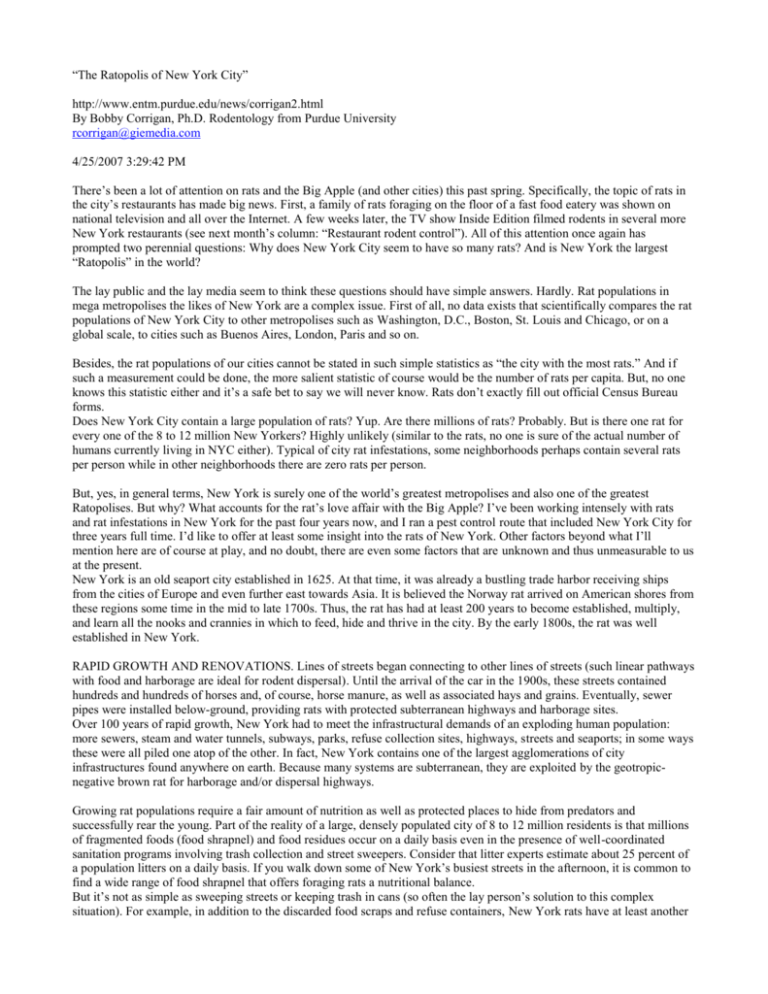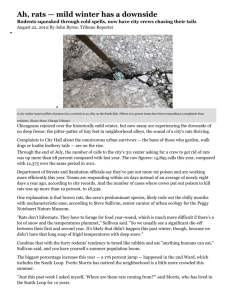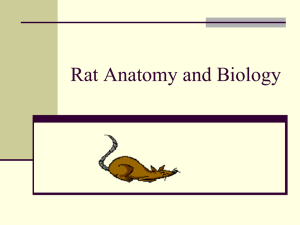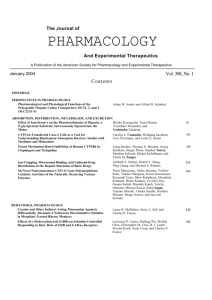L Haramis comment: Dr Corrigan is a well-known
advertisement

“The Ratopolis of New York City” http://www.entm.purdue.edu/news/corrigan2.html By Bobby Corrigan, Ph.D. Rodentology from Purdue University rcorrigan@giemedia.com 4/25/2007 3:29:42 PM There’s been a lot of attention on rats and the Big Apple (and other cities) this past spring. Specifically, the topic of rats in the city’s restaurants has made big news. First, a family of rats foraging on the floor of a fast food eatery was shown on national television and all over the Internet. A few weeks later, the TV show Inside Edition filmed rodents in several more New York restaurants (see next month’s column: “Restaurant rodent control”). All of this attention once again has prompted two perennial questions: Why does New York City seem to have so many rats? And is New York the largest “Ratopolis” in the world? The lay public and the lay media seem to think these questions should have simple answers. Hardly. Rat populations in mega metropolises the likes of New York are a complex issue. First of all, no data exists that scientifically compares the rat populations of New York City to other metropolises such as Washington, D.C., Boston, St. Louis and Chicago, or on a global scale, to cities such as Buenos Aires, London, Paris and so on. Besides, the rat populations of our cities cannot be stated in such simple statistics as “the city with the most rats.” And if such a measurement could be done, the more salient statistic of course would be the number of rats per capita. But, no one knows this statistic either and it’s a safe bet to say we will never know. Rats don’t exactly fill out official Census Bureau forms. Does New York City contain a large population of rats? Yup. Are there millions of rats? Probably. But is there one rat for every one of the 8 to 12 million New Yorkers? Highly unlikely (similar to the rats, no one is sure of the actual number of humans currently living in NYC either). Typical of city rat infestations, some neighborhoods perhaps contain several rats per person while in other neighborhoods there are zero rats per person. But, yes, in general terms, New York is surely one of the world’s greatest metropolises and also one of the greatest Ratopolises. But why? What accounts for the rat’s love affair with the Big Apple? I’ve been working intensely with rats and rat infestations in New York for the past four years now, and I ran a pest control route that included New York City for three years full time. I’d like to offer at least some insight into the rats of New York. Other factors beyond what I’ll mention here are of course at play, and no doubt, there are even some factors that are unknown and thus unmeasurable to us at the present. New York is an old seaport city established in 1625. At that time, it was already a bustling trade harbor receiving ships from the cities of Europe and even further east towards Asia. It is believed the Norway rat arrived on American shores from these regions some time in the mid to late 1700s. Thus, the rat has had at least 200 years to become established, multiply, and learn all the nooks and crannies in which to feed, hide and thrive in the city. By the early 1800s, the rat was well established in New York. RAPID GROWTH AND RENOVATIONS. Lines of streets began connecting to other lines of streets (such linear pathways with food and harborage are ideal for rodent dispersal). Until the arrival of the car in the 1900s, these streets contained hundreds and hundreds of horses and, of course, horse manure, as well as associated hays and grains. Eventually, sewer pipes were installed below-ground, providing rats with protected subterranean highways and harborage sites. Over 100 years of rapid growth, New York had to meet the infrastructural demands of an exploding human population: more sewers, steam and water tunnels, subways, parks, refuse collection sites, highways, streets and seaports; in some ways these were all piled one atop of the other. In fact, New York contains one of the largest agglomerations of city infrastructures found anywhere on earth. Because many systems are subterranean, they are exploited by the geotropicnegative brown rat for harborage and/or dispersal highways. Growing rat populations require a fair amount of nutrition as well as protected places to hide from predators and successfully rear the young. Part of the reality of a large, densely populated city of 8 to 12 million residents is that millions of fragmented foods (food shrapnel) and food residues occur on a daily basis even in the presence of well-coordinated sanitation programs involving trash collection and street sweepers. Consider that litter experts estimate about 25 percent of a population litters on a daily basis. If you walk down some of New York’s busiest streets in the afternoon, it is common to find a wide range of food shrapnel that offers foraging rats a nutritional balance. But it’s not as simple as sweeping streets or keeping trash in cans (so often the lay person’s solution to this complex situation). For example, in addition to the discarded food scraps and refuse containers, New York rats have at least another dozen opportunities in which to feed. From within each street’s corner-storm basin (145,000 of them) to sewers and subways, rats have plenty of options that also include grease films, flotsam and aquatic animals along the shorelines, pet feces, outdoor pet and pigeon feed, pigeons, cockroaches and more. With so many foods and feeding opportunities, should one source of food temporarily disappear (e.g., the food trash bags get picked up), the rat can easily shift to another source. Additionally (and importantly), rats readily collect foods in excess of their needs and carry them back to their nests or to various cache nooks in their territories where the food can be eaten by them, or by other members of the colony some time later should the local food become temporarily unavailable. Research on the rat’s caching behavior has shown rats can store up to a week’s food supply (or more) in this manner. From this aspect, alone, it is questionable whether or not it is realistically possible to limit food in a city the size, scope and intensity of New York to the level that would suppress rat populations to levels low enough to be acceptable to New Yorkers. In addition to an abundance of foods and food sources, there is also an abundance of harborages available to the New York rat. Without listing all of them, a few of the more common harborages include: (1) ground earthen burrows (beneath bushes in parks, along building perimeters in the landscaping, in tree pits, along ditch banks, highway embankments, beneath the curbs and sidewalks within the earthen fill); (2) within exterior and interior structural voids of all kinds; (3) within old sewer systems and other tunnel-oriented infrastructures (nearby water and steam lines, electrical chases, telecommunications, etc.); (4) within the protected zones of subway platforms and track tunnels; (5) within and/or beneath junk, discarded furniture, abandoned cars, etc. So, even based on just this partial profile of the New York rat, it is easy to see why the rat “loves” New York City, and how it can breed and breed and breed. THE FUTURE. Will we ever achieve a higher level of rat management in New York and similar metropolises? When you ask the lay public this question, many think the answer lies in future scientific developments that will result in better traps or poisons. But in those urban areas where the rat is thriving, it actually has very little to do with traps and baits. The answer is both simple and complex at the same time. Homo sapiens (meaning wise man) could be far wiser by taking a lesson from many of the lower mammals and animals: that is, keeping its own nest cleaner, and like the ants, do a better job at working together despite all “the fences.” This just doesn’t mean with the neighbor next door but across national, state and city agency fences as well. But for sure the most important aspect must occur at the individual level first, and the municipal level second. In a high-density city like New York, only a small percentage of 10 million residents who foul the nest is a lot of food and harborage for rodents (and flies and cockroaches, pigeons, etc.). And therein lies the complexity and the frustration. Nature is full of examples of one animal benefiting from the “leftovers,” wastes, and evacuated or abandoned harborages of another (e.g., jackals feeding on what’s left from the lion; ants feeding below on the dropped foods of the birds above, gulls following a fishing boat for discarded fish entrails, the rabbit occupying the abandoned woodchuck den, the yellowjacket nest in the evacuated chipmunk burrow and so on). In other words, ecologically speaking, where you find one animal, there is often a list of associated commensal and parasitic animals that “follow.” So too for city rodents and city people. They all are co-existing city dwellers. And, of course, this is not just in New York but in most large-scale urban human habitations the world over. John McLoughlin in his 1976 urban inquilines book, “The Animals Among Us,” provides one of the best summary statements on the relationship between the city rat and urbanites: “All the ingenious traps, all the virulent poisons, all the cunning predators domesticated by offended humanity have served to cause only momentary fluctuations in localized populations of rats. The world rat population rises in direct proportion to the world’s human population, and neither species shows any sign of faltering.” The author is president of RMC Consulting, Richmond, Ind., and can be reached via e-mail at rcorrigan@giemedia.com. New York Tackles Its Gnawing Rat Problem Purdue Alum BS '77, MS '80, PhD '95 By David Segal Washington Post Staff Writer March 20, 2007 NEW YORK -- "This is a New York City rat," Robert Corrigan says, reaching into his bag and pulling out a nine-inch rodent. It's light brown and -- you are relieved to realize -dead and stuffed. He drops the critter in the lobby of the Cosmopolitan Hotel in Tribeca, where it sits, paws splayed on the floor, ready to scare the tar out of a German tourist. "That's the typical rat here," Corrigan explains. "A lot is made of it. 'It's giant. It's a foot long.' That's it. They're rarely any larger than that." Corrigan, an earnest 56-year-old from the Midwest with a PhD in rodentology -seriously, that's what it's called -- is Pest control pro Robert Corrigan, on assignment in rodent-infested Manhattan, uses a stuffed rat to show the size of the New York species. By David Segal -- The Washington Post suggesting that the local varmints aren't quite as menacing as lore has it. But he didn't fly into town on Sunday, prop in hand, to burnish the image of the world's most loathed mammal. Quite the opposite. He's come to help New York City recover from a major ratrelated fiasco. Maybe you caught the video: A KFC/Taco Bell restaurant in the West Village, overrun by rats, some of them nibbling atop lunch trays, others scampering near trash bags, all of them snacking at their leisure in the hours before the place opened for business. By then, the video -- shot by a local news cameramen on a tip from appalled passersby -- was on its way to the heavy rotation that only cable TV and YouTube can provide. The story mushroomed into a city government scandal when it turned out that a restaurant inspector had given the infested KFC/Taco Bell a passing grade the day before the rats gone wild video was taped. Oops. The Department of Health and Mental Hygiene removed that inspector from duty and announced that all 100 of the city's inspectors would take a remedial run through Rodent Control Academy. Launched in 2005, the academy is a three-day master class in the fine art of smelling a rat, as well as background about the biology and behavior of the animals, and tips on how to stalk and poison them. As with previous rodent academy courses, this one will be taught by Corrigan. "You actually can smell a rat," he says on Sunday afternoon. "I've been to plenty of fancy restaurants where I walk in with some friends and say 'We're not eating here,' and we turn around and walk out." It smells like a musty locker room, in case you were wondering. That is just one rat lesson learned during an hourlong stroll with Corrigan around a typical city block. He's been asked by a reporter to explain the astounding durability of these creatures and to point out all the places where rats nest, eat and hide. He has agreed under one condition: that the block be granted anonymity. "If people knew which block we were talking about, they might freak out about it," Corrigan says. "And it doesn't matter which block because just about any block in New York has the same problems." Deal. What you realize soon after this narrated jaunt begins is that New York City is a rat Valhalla, a perfect combination of hideaways, easy-to-gnaw garbage bags and strewn-about food. "You see that?" Corrigan says, pointing to a tiny hole near the front of a posh gym. "A rat needs just half an inch to crawl in. That's it. So that's plenty of room. To a rat, this is a wide-open door." Born in Brooklyn but having no trace of an accent, Corrigan is earnest about his work, but not above the occasional grin that says, Yes, I have a very strange job. He is married and lives in Indiana. By his estimation, he is one of about a dozen pest-control consultants who work with cities, corporations and buildings, devising plans on the macro level to curtail rats. Most of his clients demand confidentiality. Others, like New York -- as well as Washington, where Corrigan has taught his seminar to city employees -- publicize their efforts. Yum! Brands, the company that franchises Taco Bell and KFC, issued a statement when it hired Corrigan recently to help improve pest-control standards. "I give them credit for being so public about it," Corrigan says. The key to Corrigan's success is understanding both how bureaucrats and rats think. He learned the latter during his graduate student days at Purdue University, when he once spent 30 days in a rat-infested barn in Indiana. He lived the nocturnal life of his subjects, watching them eat and reproduce. They crawled all over him. The more he watched the animals, the more he liked them. "They're masters at adaptation and incredibly sophisticated," he says. "A research paper came out recently that said that rats contemplate their actions. They might run along a wall, stop and think, 'Is this a good move?' " He doesn't do much rat killing, though as a former exterminator he's killed his share. Instead, he teaches clients where rats live, how they breed, their preferences when it comes to shrubbery and garbage cans. "Those garbage cans are on stanchions," he says, as he walks through a park. "That's good. Rats prefer garbage cans that are on the ground." He heads down an alley. Corrigan has been here on nights when the row of trash bags seemed to bustle with life. "It was like each rat got its own bag," he says. A year ago, a bunch of traps were set here and Corrigan inspects them as he walks. He has keys to unlock the traps and opens one. Thankfully, it's empty. These traps contain poisoned cubes of what looks like granola, apparently a delicious treat for a rat that kills it in five days, after a whole lot of internal bleeding. You'd think a device like this would at least put a dent in the problem, and maybe even represent hope in the ongoing man vs. rat brawl. Nah. "Seen any rats?" Corrigan shouts, to a man digging a hole in the street at the end of the alley. "Yes," the man replies, a little indignantly. It's like someone asked if he knew how to breathe. It’s Man vs. Pest at the Academy, and the Winner Is ... Purdue Alum BS '77, MS '80, PhD '95 By SEWELL CHAN The New York Times December 5, 2006 Robert M. Corrigan is one of the nation’s foremost experts in rodent control, but it is a different species that riles him up the most. "Are we very smart?" he asked his students last month, suggesting that a creature known as Homo sapiens, roughly translated to "wise man," should know better. "We want the rats to go away, but we keep trash under our desks. We want the city to kill the rats, but we throw McDonald’s bags out the car window." The students are 70 city and state officials from a broad array of agencies: Sanitation, Parks and Recreation, Housing, Preservation and Development and the Metropolitan Transportation Authority. They are taking part in a three-day Rodent Control Academy, which Dr. Corrigan has taught periodically for the last year. Robert M. Corrigan The classes, financed by a federal grant, are perhaps the most visible sign that the city is rethinking its strategy on controlling rats and mice. Dr. Corrigan is a leading proponent of the shift away from extermination and poisons to a new preventative approach called integrated pest management. A balding, energetic man of 56 whose accent reflects his childhood in East Flatbush, Brooklyn, he said he had a lifelong curiosity about creatures that generally repel. "I always was interested in insects, rodents, creepy-crawlies that most people find disgusting," he said. For several years in the 1970s, he worked for an extermination company in Manhattan, inspecting restaurants for the city and killing mice and rats for scores of private customers. His love of science led him to Purdue University, where he earned three degrees, including a doctorate in vertebrate pest management. Now he runs a consulting company in Richmond, Ind. The academy covers everything from the role of rodents in exacerbating allergenic diseases to the proper ways to bait a rat burrow. The lessons are bolstered by dozens of handouts, a field trip and a final exam. Rats love rotting trash, but they also feed on other creatures - insects, fish, pigeons and even other rats - as well as cat food and undigested matter in dog feces. A rat can crawl through a hole as small as half an inch, the diameter of its skull. Rats thrive in burrows, holes in walls, subway tunnels, sewers, empty lots and alleys. Controlling them requires everything from proper use of garbage bins by restaurants to the right choice of landscaping by managers of apartment buildings. (Dr. Corrigan recommends vase-shaped shrubs rather than dense evergreens, like yew bushes, which cover hiding places on the ground.) Dr. Corrigan loves dispelling myths like these: there is one rat per person (the number is impossible to estimate); rats grow to the size of adult cats (rats can be up to 18 inches long, from nose to tail); rats live long lives (typical lifespan: five to nine months); and poison is a panacea. On the last point, Dr. Corrigan returns to his core message again, that humans create the habitats that allow rats to flourish. Poison alone will not work. It takes methodical, coordinated and sustained efforts to control rats. "This is a big, long, complex problem for which there is no easy, quick solution," he said.






